Resolutions of the Symposium on the introduction of contemporary ...
Resolutions of the Symposium on the introduction of contemporary ...
Resolutions of the Symposium on the introduction of contemporary ...
Create successful ePaper yourself
Turn your PDF publications into a flip-book with our unique Google optimized e-Paper software.
<str<strong>on</strong>g>Resoluti<strong>on</strong>s</str<strong>on</strong>g> <str<strong>on</strong>g>of</str<strong>on</strong>g> <str<strong>on</strong>g>the</str<strong>on</strong>g> <str<strong>on</strong>g>Symposium</str<strong>on</strong>g> <strong>on</strong> <str<strong>on</strong>g>the</str<strong>on</strong>g> introducti<strong>on</strong><br />
<str<strong>on</strong>g>of</str<strong>on</strong>g> c<strong>on</strong>temporary architecture into ancient groups<br />
<str<strong>on</strong>g>of</str<strong>on</strong>g> buildings, at <str<strong>on</strong>g>the</str<strong>on</strong>g> 3rd ICOMOS General<br />
Assembly (1972)<br />
The Internati<strong>on</strong>al <str<strong>on</strong>g>Symposium</str<strong>on</strong>g> <strong>on</strong> <str<strong>on</strong>g>the</str<strong>on</strong>g> introducti<strong>on</strong> <str<strong>on</strong>g>of</str<strong>on</strong>g> c<strong>on</strong>temporary architecture into ancient<br />
groups <str<strong>on</strong>g>of</str<strong>on</strong>g> buildings, meeting in Budapest <strong>on</strong> 27th and 28th June 1972, at <str<strong>on</strong>g>the</str<strong>on</strong>g> time <str<strong>on</strong>g>of</str<strong>on</strong>g> <str<strong>on</strong>g>the</str<strong>on</strong>g><br />
Third General Assembly <str<strong>on</strong>g>of</str<strong>on</strong>g> <str<strong>on</strong>g>the</str<strong>on</strong>g> Internati<strong>on</strong>al Council <strong>on</strong> M<strong>on</strong>uments and Sites,<br />
Expresses its heartiest thanks and c<strong>on</strong>gratulati<strong>on</strong>s to <str<strong>on</strong>g>the</str<strong>on</strong>g> Hungarian Nati<strong>on</strong>al Committee <str<strong>on</strong>g>of</str<strong>on</strong>g><br />
ICOMOS and to <str<strong>on</strong>g>the</str<strong>on</strong>g> Hungarian Government, by whom it has been so warmly and<br />
efficiently received, and<br />
After hearing <str<strong>on</strong>g>the</str<strong>on</strong>g> c<strong>on</strong>tents both <str<strong>on</strong>g>of</str<strong>on</strong>g> <str<strong>on</strong>g>the</str<strong>on</strong>g> papers presented during its sessi<strong>on</strong>s <strong>on</strong> questi<strong>on</strong>s <str<strong>on</strong>g>of</str<strong>on</strong>g><br />
doctrine and <strong>on</strong> certain significant achievements, and <str<strong>on</strong>g>of</str<strong>on</strong>g> <str<strong>on</strong>g>the</str<strong>on</strong>g> subsequent discussi<strong>on</strong>s,<br />
Recognizing that, at <str<strong>on</strong>g>the</str<strong>on</strong>g> present state <str<strong>on</strong>g>of</str<strong>on</strong>g> development <str<strong>on</strong>g>of</str<strong>on</strong>g> civilizati<strong>on</strong>, technological and<br />
ec<strong>on</strong>omic questi<strong>on</strong>s unduly divert attenti<strong>on</strong> from human and social values, that <str<strong>on</strong>g>the</str<strong>on</strong>g><br />
increasingly rapid growth <str<strong>on</strong>g>of</str<strong>on</strong>g> towns renders it urgently necessary for systematic provisi<strong>on</strong> to<br />
be made for <str<strong>on</strong>g>the</str<strong>on</strong>g> envir<strong>on</strong>ment <str<strong>on</strong>g>of</str<strong>on</strong>g> daily life and for <str<strong>on</strong>g>the</str<strong>on</strong>g> preservati<strong>on</strong> <str<strong>on</strong>g>of</str<strong>on</strong>g> historic m<strong>on</strong>uments<br />
and groups <str<strong>on</strong>g>of</str<strong>on</strong>g> buildings, and that such preservati<strong>on</strong>, which thus becomes vital, is feasible<br />
<strong>on</strong>ly if <str<strong>on</strong>g>the</str<strong>on</strong>g> latter are made to play an active part in c<strong>on</strong>temporary life,<br />
C<strong>on</strong>sidering that groups <str<strong>on</strong>g>of</str<strong>on</strong>g> buildings <str<strong>on</strong>g>of</str<strong>on</strong>g> historical interest forma fundamental part <str<strong>on</strong>g>of</str<strong>on</strong>g> <str<strong>on</strong>g>the</str<strong>on</strong>g><br />
human envir<strong>on</strong>ment, that architecture is necessarily <str<strong>on</strong>g>the</str<strong>on</strong>g> expressi<strong>on</strong> <str<strong>on</strong>g>of</str<strong>on</strong>g> its age, that its<br />
development is c<strong>on</strong>tinuous, and that its past, present and future expressi<strong>on</strong> must be treated<br />
as a whole, <str<strong>on</strong>g>the</str<strong>on</strong>g> harm<strong>on</strong>y <str<strong>on</strong>g>of</str<strong>on</strong>g> which must be c<strong>on</strong>stantly preserved, and that any historical<br />
m<strong>on</strong>ument or complex <str<strong>on</strong>g>of</str<strong>on</strong>g> buildings possesses an intrinsic value independently <str<strong>on</strong>g>of</str<strong>on</strong>g> its initial<br />
role and significance which enables it to adapt itself to a changing cultural, social,<br />
ec<strong>on</strong>omic and political c<strong>on</strong>text while fully retaining its structure and character.<br />
Hereby adopts <str<strong>on</strong>g>the</str<strong>on</strong>g> following c<strong>on</strong>clusi<strong>on</strong>s:<br />
1. The introducti<strong>on</strong> <str<strong>on</strong>g>of</str<strong>on</strong>g> c<strong>on</strong>temporary architecture into ancient groups <str<strong>on</strong>g>of</str<strong>on</strong>g> buildings is<br />
feasible in so far as <str<strong>on</strong>g>the</str<strong>on</strong>g> town-planning scheme <str<strong>on</strong>g>of</str<strong>on</strong>g> which it is a part involves<br />
acceptance <str<strong>on</strong>g>of</str<strong>on</strong>g> <str<strong>on</strong>g>the</str<strong>on</strong>g> existing fabric as <str<strong>on</strong>g>the</str<strong>on</strong>g> framework for its own future development.<br />
2. Such c<strong>on</strong>temporary architecture, making deliberate use <str<strong>on</strong>g>of</str<strong>on</strong>g> present-day techniques<br />
and materials, will fit itself into an ancient setting without affecting <str<strong>on</strong>g>the</str<strong>on</strong>g> structural<br />
and aes<str<strong>on</strong>g>the</str<strong>on</strong>g>tic qualities <str<strong>on</strong>g>of</str<strong>on</strong>g> <str<strong>on</strong>g>the</str<strong>on</strong>g> latter <strong>on</strong>ly in so far as due allowance is made for <str<strong>on</strong>g>the</str<strong>on</strong>g><br />
appropriate use <str<strong>on</strong>g>of</str<strong>on</strong>g> mass, scale, rhythm and appearance.<br />
3. The au<str<strong>on</strong>g>the</str<strong>on</strong>g>nticity <str<strong>on</strong>g>of</str<strong>on</strong>g> historical m<strong>on</strong>uments or groups <str<strong>on</strong>g>of</str<strong>on</strong>g> buildings must be taken as a<br />
basic criteri<strong>on</strong> and <str<strong>on</strong>g>the</str<strong>on</strong>g>re must be avoidance <str<strong>on</strong>g>of</str<strong>on</strong>g> any imitati<strong>on</strong>s which would affect<br />
<str<strong>on</strong>g>the</str<strong>on</strong>g>ir artistic and historical value.
4. The revitalizati<strong>on</strong> <str<strong>on</strong>g>of</str<strong>on</strong>g> m<strong>on</strong>uments and groups <str<strong>on</strong>g>of</str<strong>on</strong>g> buildings by <str<strong>on</strong>g>the</str<strong>on</strong>g> finding <str<strong>on</strong>g>of</str<strong>on</strong>g> new uses<br />
for <str<strong>on</strong>g>the</str<strong>on</strong>g>m is legitimate and recommendable provided such uses affect, whe<str<strong>on</strong>g>the</str<strong>on</strong>g>r<br />
externally or internally, nei<str<strong>on</strong>g>the</str<strong>on</strong>g>r <str<strong>on</strong>g>the</str<strong>on</strong>g>ir structure nor <str<strong>on</strong>g>the</str<strong>on</strong>g>ir character as complete<br />
entities.<br />
And recommends that <str<strong>on</strong>g>the</str<strong>on</strong>g>re be held regular discussi<strong>on</strong> meetings <strong>on</strong> <str<strong>on</strong>g>the</str<strong>on</strong>g> harm<strong>on</strong>ious<br />
introducti<strong>on</strong> <str<strong>on</strong>g>of</str<strong>on</strong>g> c<strong>on</strong>temporary architecture into ancient groups <str<strong>on</strong>g>of</str<strong>on</strong>g> buildings at which codes<br />
<str<strong>on</strong>g>of</str<strong>on</strong>g> procedure and achievements in this field may be examined in <str<strong>on</strong>g>the</str<strong>on</strong>g> light <str<strong>on</strong>g>of</str<strong>on</strong>g> <str<strong>on</strong>g>the</str<strong>on</strong>g> above<br />
c<strong>on</strong>clusi<strong>on</strong>s.<br />
Budapest, 30th June 1972.



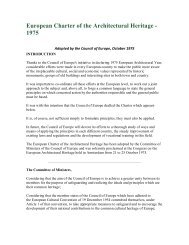

![Diario de doble entrada [FORMULARIO] - ICOMOS Costa Rica](https://img.yumpu.com/49864332/1/190x245/diario-de-doble-entrada-formulario-icomos-costa-rica.jpg?quality=85)


![Diario de doble entrada [EXPLICACIÃN] - ICOMOS Costa Rica](https://img.yumpu.com/48810226/1/190x245/diario-de-doble-entrada-explicacian-icomos-costa-rica.jpg?quality=85)

![Diario de doble entrada [FORMULARIO] - Icomos](https://img.yumpu.com/47521191/1/190x245/diario-de-doble-entrada-formulario-icomos.jpg?quality=85)
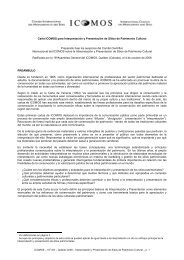
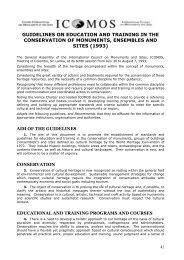
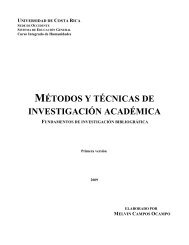
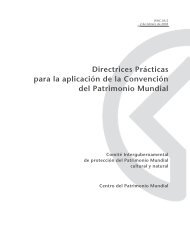

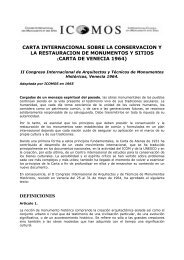
![Diario de doble entrada [EJEMPLO] - Icomos](https://img.yumpu.com/39300144/1/190x245/diario-de-doble-entrada-ejemplo-icomos.jpg?quality=85)